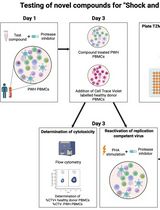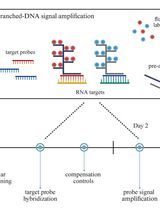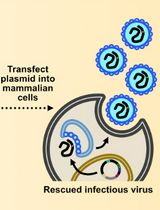- EN - English
- CN - 中文
Intestinal Enteroid Culture for Human Astroviruses
人类星状病毒的肠样培养
(*contributed equally to this work) 发布: 2020年07月20日第10卷第14期 DOI: 10.21769/BioProtoc.3687 浏览次数: 4679
评审: David PaulGundeep KaurAnonymous reviewer(s)

相关实验方案

诱导型HIV-1库削减检测(HIVRRA):用于评估外周血单个核细胞中HIV-1潜伏库清除策略毒性与效力的快速敏感方法
Jade Jansen [...] Neeltje A. Kootstra
2025年07月20日 2373 阅读

基于Flow-FISH的流式细胞术检测终止型与延伸型HIV-1转录本阳性细胞的定量分析
Shirley Man [...] Neeltje A. Kootstra
2025年07月20日 2070 阅读
Abstract
Human astroviruses (HAstV) are non-enveloped, positive-sense single stranded RNA viruses that typically cause gastroenteritis in children, the elderly and among immunocompromised individuals. Some HAstV species have also been implicated in neurological diseases. It is important to study these viruses to understand the pathogenesis and develop therapeutics. Here we describe HAstV infection in epithelium-only human intestinal enteroids (HIE) isolated from biopsy-derived intestinal crypts. Although different HAstV clades have been propagated in transformed immortalized cell lines such as A549, Caco-2, HEK293T and Huh7.5, we chose HIE because they better mimic the human intestine and thus are more physiologically relevant. Additionally, HIE support the replication of all HAstV clades including clinical samples, thus making HIE a valuable potential universal model to study HAstV biology.
Keywords: Astrovirus (星状病毒)Background
Human astroviruses (HAstV) are enteric viruses that are highly prevalent, causing widespread infections ranging from diarrhea to encephalitis. Asymptomatic, systemic and extra-intestinal infections are common (Madeley and Cosgrove 1975; Bosch et al., 2014; Kolawole et al., 2019). Despite their medical importance, HAstV are some of the least characterized enteric viruses. Currently, three groups of human AstV are recognized: classic HAstV, and non-classic HAstV-MLB (Melbourne), and HAstV-VA/HMO (Virginia/Human-Mink-Ovine-like) with each group containing multiple strains. Several immortalized cell lines have been developed for successful propagation of multiple HAstV strains. Human colon carcinoma Caco-2 cells are commonly used to propagate all eight serotypes of classic HAstV. As for the non-classic HAstV, Caco-2 cells, human embryonic kidney HEK293T, adeno-carcinomic human lung epithelial A549, and primary astrocytes were only recently described to support VA1 propagation (Janowski et al., 2017 and 2019). In addition, A549 and human liver Huh7 were developed to propagate MLB1 and MLB2 (Vu et al., 2019). However, no single culture system supports the replication of all tested species. The lack of a robust, physiologically relevant viral propagation system for genetically diverse viruses from all clades has created a fundamental gap in our understanding about the biology of HAstV. For example, little or no information is available on the in vivo cell tropism, pathophysiology, and host responses to HAstV infection.
Human intestinal enteroids (HIE) are nontransformed in vitro models that recapitulate many characteristics of the gastrointestinal tract. HIE are derived from stem cells isolated from human intestinal biopsy tissues or surgical resections. Thus, this system exhibits multiple advantages over traditional transformed intestinal cell lines (e.g., Caco-2 cells). These include the non-transformed status, the presence of multiple cell types, the specific regional characteristics and host genetics of the donor and the ability to differentiate from crypt-like into villus-like cell populations (Kolawole et al., 2019; Kolawole and Wobus, 2020). There are some drawbacks involved with using HIE. Examples include donor-to-donor variability, inability of HIE to completely mimic the cellularity of the intestine in vivo and the major investment needed for culture maintenance. However, HIE have been used to culture human rotavirus, norovirus and astrovirus by breaking apart the 3D spheres in which they are normally organized in culture (Figure 1, left) and seeding as 2D monolayer (Figure 1, right) (Kolawole and Wobus, 2020). Here, we describe our methods of HIE maintenance and AstV infection. Laboratory adapted samples of HAstV1, MLB1 and VA1 represented HAstV clades that were propagated in HIE. HAstV5-positive stool sample was also used to propagate clinical HAstV in HIE. All infections were performed in 2D monolayers. These protocols, with the required specific adjustments, should facilitate the study of HAstV and other enteric viruses.
Materials and Reagents
- 1.7 ml popsi-click centrifuge tubes (Denville, catalog number: C2170 )
- U-bottom 96-well plates (Falcon, catalog number: 353077 )
- 48-well plates (Costar, catalog number: 3548 )
- 24-well plates Nunclon delta surface (Thermo Scientific, catalog number: 142475 )
- 6-well plates (CytoOne, catalog number: CC7682 )
- P1000 pipette tips (Denville, catalog number: 1159M42 )
- P200 pipette tips (Denville, catalog number: 1159M40 )
- P20 pipette tips (Denville, catalog number: 1159M43 )
- 1 ml disposable syringe (BD, catalog number: 309659 )
- 25G x 5/8″ PrecisionGlide needle (BD, catalog number: 305122 )
- Cell strainer, 40 μm nylon mesh (Fisherbrand, catalog number: 22363547 )
- 15 ml conical tubes (Falcon, catalog number: 352096 )
- Sterile 500 ml vacuum filtration systems (0.22 μm, PES membrane; Corning, catalog number: 431097 )
- Sterile 250 ml vacuum filtration systems (0.22 μm, PES membrane; Corning, catalog number: 431096 )
- Sterile 50 ml vacuum filtration systems (0.22 μm; Millipore, catalog number: SCGP00525 )
- Matrigel matrix (Corning, catalog number: 354234 )
- Fetal bovine serum (FBS; HyClone, catalog number: SH30396.03 )
- LWRN cells (ATCC, catalog number: CRL-3276 )
- Advanced DMEM/F-12 (Invitrogen, catalog number: 12634-028 )
- N-2 media supplement (Invitrogen, catalog number: 17502-048 )
- Phosphate buffered saline (PBS-/-; Gibco, catalog number: 10010-023 )
- Dulbecco’s phosphate buffered saline with calcium and magnesium (PBS+/+; Gibco, catalog number: 14040-133 )
- HEPES (1 M; Invitrogen, catalog number: 15630-080 )
- 5000 units/ml penicillin/streptomycin (Invitrogen, catalog number: 15070-063 )
- Geneticin, G418 (Gibco, catalog number: 10131-035 )
- Hygromycin B (Invitrogen, catalog number: 10687010 )
- Puromycin (Sigma-Aldrich, catalog number: P8833 )
- GlutaMax (Invitrogen, catalog number: 17504-044 )
- B-27 supplement minus vitamin A (Invitrogen, catalog number: 17504-044 )
- N-Acetyl-L-cysteine (Sigma-Aldrich, catalog number: A9165-5G )
- Mouse EGF (Invitrogen, catalog number: PMG8043 )
- SB202190 (Sigma-Aldrich, catalog number: S7067 )
- A83-01 (Tocris, catalog number: 2939 )
- Nicotinamide (Sigma-Aldrich, catalog number: N0636 )
- Leu15-Gastrin I (Sigma-Aldrich, catalog number: G9145 )
- Y-27632 (Sigma-Aldrich, catalog number: Y0503 )
- Human collagen IV (Sigma, catalog number: C5533 )
- Porcine trypsin (Sigma-Aldrich, catalog number: T-0303 )
- 0.05% Trypsin-EDTA (Gibco, catalog number: 25300-054 )
- Recovery cell culture freezing medium (Gibco, catalog number: 12648-010 )
- Glacial acetic acid (Thermo Scientific, catalog number: A38-211 )
- UltraPure distilled water (Invitrogen, catalog number: 10977-015 )
- Dimethyl sulfoxide (DMSO; Sigma, catalog number: D2650 )
- Accumax (STEMCELL technologies, catalog number: 0 7921 )
- LIVE/DEAD fixable aqua dead cell stain kit (Thermo Fisher Scientific, catalog number: L34957 )
- Fixation/Permeabilization concentrate (eBioscience, catalog number: 00-5123-43 )
- Biotin-conjugated primary dsRNA (J2; Scicons, catalog number: 10010200 )
- Rabbit anti-ZO1 primary antibody (Thermo Fisher Scientific, catalog number: 61-7300 )
- Mouse anti-VA1 polyclonal serum (primary antibody; made in our lab)
- Secondary anti-rabbit AlexaFluor 594 (Thermo Fisher Scientific, catalog number: A32740 )
- Secondary anti-mouse AlexaFluor 647(Thermo Fisher Scientific, catalog number: A32728 )
- Ulex europeus agglutinin 1 (UEA-1) lectin conjugated with FITC (Thermo Fisher Scientific, catalog number: L32476 )
- 4’,6-Diamidino-2-phenylindole (DAPI; Sigma-Aldrich, catalog number: D9542 )
- ProLong Gold antifade reagent (Thermo Fisher Scientific, catalog number: P36930 )
- Transwell permeable support (Costar, catalog number: 3413 )
- Stock solutions (see Recipes)
500 mM N-acetyl cysteine
50 μg/ml Mouse EGF
500 mM A-83-01
10 mM SB202190
1 M Nicotinamide
10 μM Leu15-Gastrin
10 mM Y-27632 - Media (see Recipes)
Advanced DMEM-20
LWRN conditioned medium
Noggin conditioned medium
LWRN- medium (1%)
LWRN+ (with growth factors)
Differentiation medium
Equipment
- 37 °C incubator (Thermo Scientific Heracell 150i CO2 Incubator)
- 37 °C water bath (Thermo Electron Corporation)
- -80 °C freezer
- Benchtop Centrifuge (Sorval legend RT)
- Hemocytometer (Reichert)
- P1000 pipette (Eppendorf Research)
- P200 pipette (Eppendorf Research)
- P20 pipette (Eppendorf Research)
- Vacuum aspirator
- Biosafety hood (SterilGARD® III Advance)
- Light microscope (Fisher Scientific)
- Cell counter
Procedure
文章信息
版权信息
© 2020 The Authors; exclusive licensee Bio-protocol LLC.
如何引用
Owusu, I. A., Mirabelli, C. and Kolawole, A. O. (2020). Intestinal Enteroid Culture for Human Astroviruses. Bio-protocol 10(14): e3687. DOI: 10.21769/BioProtoc.3687.
分类
微生物学 > 微生物-宿主相互作用 > 病毒
免疫学 > 宿主防御 > 综合
细胞生物学 > 基于细胞的分析方法 > 流式细胞术
您对这篇实验方法有问题吗?
在此处发布您的问题,我们将邀请本文作者来回答。同时,我们会将您的问题发布到Bio-protocol Exchange,以便寻求社区成员的帮助。
Share
Bluesky
X
Copy link












